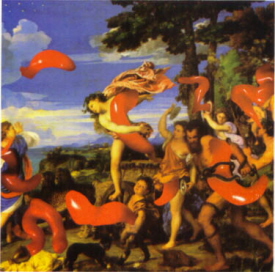Audio Visuals: Juno Reactor's Voice and the "Vertical Story"
"It's not," he pauses, "necessarily a linear story. I think you can have stories that are just different levels going up and down rather than elongated. Or ones that have a kinetic energy that are rolling along. I quite like the vertical story." And without a pause, as though he'd caught this idea long ago and it comes as second nature, Watkins explains his "vertical story."
"There was Jardin de Cecile. It was about a girl that was murdered by an English truck driver. The [girl's] father came from France and wrote on the tree where they found the body 'Jardin de Cecile.' I'd just had my first kid and it was like my heart," he stops and then begins again, "like someone blew it up. So I wanted to create this garden that I saw.
I thought it was such a beautiful thing to do. You know he wrote in anger, I'm sure he wasn't angry at her, but I thought it was such a beautiful thing to do, write on a tree 'Jardin de Cecile.' And I just thought that's a story within itself. That is the story, making this heavenly garden."
And he believes that the "vertical story" is also well told in the track "God is God," which has gone through several remixes. "It's [God is God] sort of topical now. Unless we get to this point of tolerance between the religions and the faiths, this is what you'll get. It's this Armageddon, book of Revelation, really, wrath of God."
And what about the remixes? Are they each individual subplots of the larger story? "Not really. I think it's just that at that time, everyone wanted a remix." Yet even in the remixes, Watkins has a strong sense of the voice he prefers. "My natural vibe is to go with the book of Revelations one," he says, "but I like the other ones as well."
Plays Nicely with Others, Check
Collaborations are a large part of the music as well. Juno Reactor has worked with tribal groups, Taiko drummers and Watkins has worked with orchestras to create an electronic symphony sound as well. How does Juno Reactor keep its voice?
"I really like working with people who want to work with me and have a really good vibe about it. When you're working positively with someone, there's so much you can do with them. It's amazing how much you can feed off them. I work a lot with Greg Ellis out in L.A. and it's like we're in the same room. With others, you can be in the same room and it's like you're miles from each other, you know, they've got different agendas.
I like working with people like guitarist Eduardo Niebla who doesn't mind feeding me whatever I want. And like Mabi, I mean everyone's a one off, but Mabi is definitely a one off."
And what about working with other cultures in cross cultural mixes of music? "With music, all you have is the same language: smiling. Like with Mabi, when he's slamming into it and beaming back at you and you're beaming back at him, you've got such a vibe that there's no mistaking the language of what he's doing. It's the same with the girls in Tokyo, the energy, power and passion that they put into it was unmistakable."
Always on the Move
Juno Reactor came onto the scene at the height of Goa Trance. I asked Watkins to explain the growth of his music. "I was really into industrial and electronic before, and into rock music and classical music. What I think was good about the early days of Goa Trance was that it gave things a new discipline. The DJ's in those days were a great help. I went through massive learning processes of being able to play with arrangements. You can look at some of the early tracks and see what's happening... They're really simple and you can see what's happening with four, eight, sixteen and thirty two bars, playing off of sixteens and eights, nothing particularly complicated. But at the same time, the structures are very clearly defined.
The great thing for people like me and people I was working with could be not embarrassed by the simplicity of it. It all felt really new and good fun and we knew who we were making it for. That gave us a structure; a skeleton we could work off of and the more we did it, the more flesh we could put on it."
Once Watkins called it "collision music." Did that description still hold true?

Jardin de Cecile by Simon Watkins
